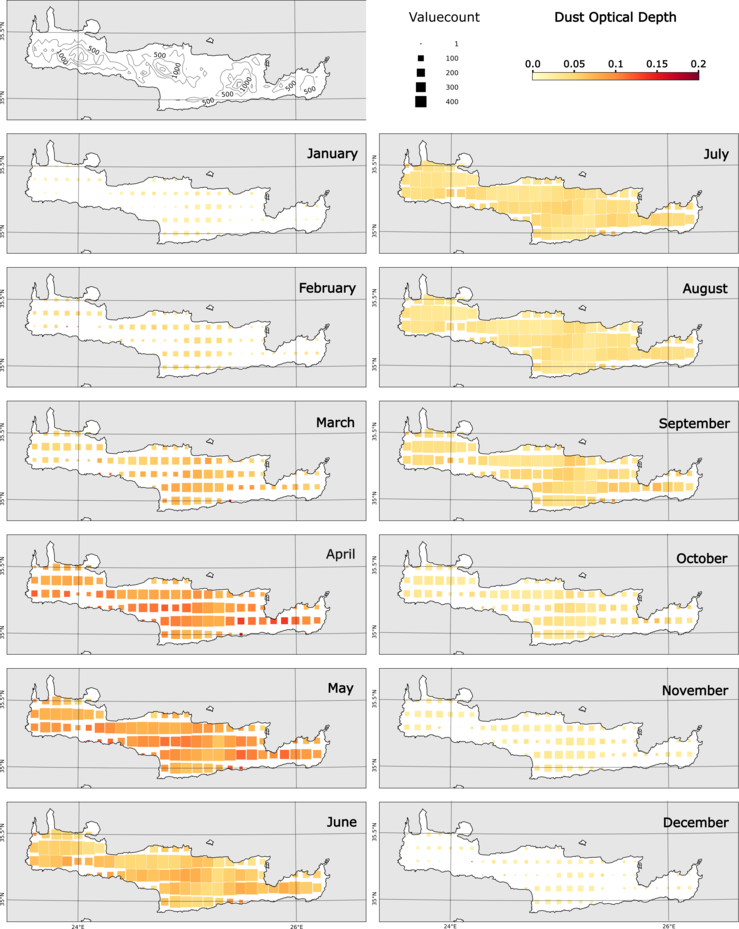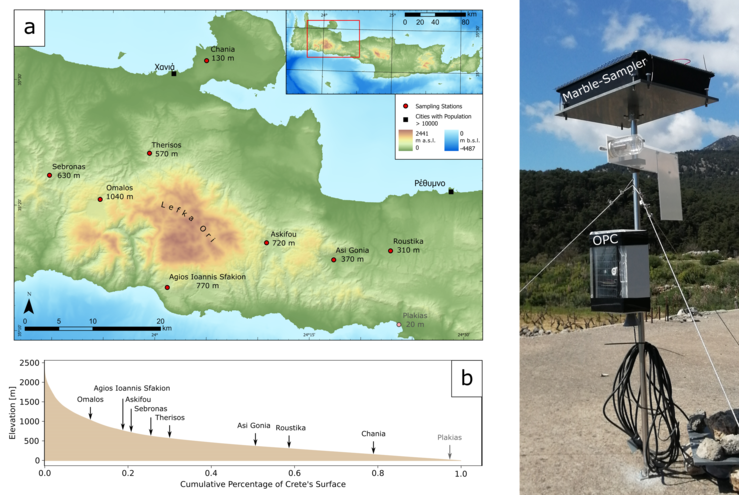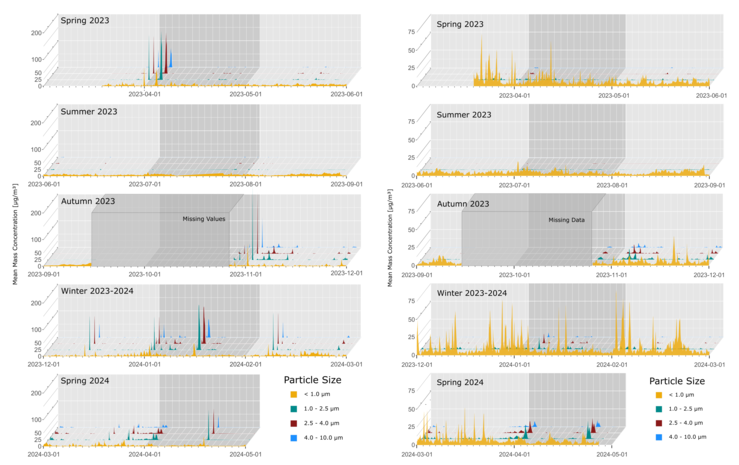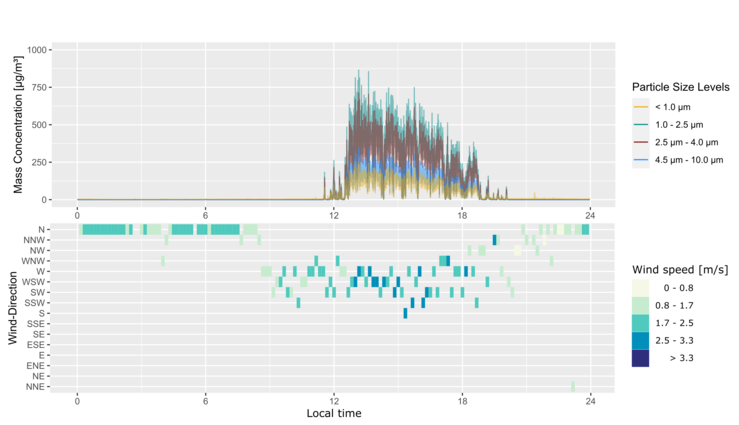Spatial and temporal patterns of dust inputs in the eastern Mediterranean region (focus: Crete) and their composition and significance for current soil formation processes
Institute of Geographical Sciences, Physical Geography • Institute of Meteorology, Remote sensing
Research Commission FU Berlin

Due to its proximity to the Sahara, the eastern Mediterranean region is in the area of influence of the largest global source of dust in terms of emission flow. A total of 400 - 2,200 tg/year of dust particles are emitted in North Africa, with up to 15 % being transported towards the Mediterranean. While the western Mediterranean region is already comparatively well researched in terms of provenances, trajectories and geochemical signatures of long-range dust, there are still considerable gaps in research in the eastern Mediterranean region. Due to its location and topography, Crete is a very suitable study area.
In order to achieve a comprehensive view of the prevailing transport and deposition processes and the influence of dust on soil formation in the deposition areas, meteorological and physical-geographical methods are combined in this pilot study.
Using Aerosol Optical Depth (AOD) MODIS and Dust Optical Depth (DOD) MIDAS data, the annual variation of dust concentrations over Crete was calculated for the period from 2003 to 2017. However, both the spatial and temporal resolution of the satellite data are too low for a more precise analysis of the spatial distribution and the influence of relief on the dust fluxes. Furthermore, as the AOD and the DOD calculated from it can only be recorded when the sky is cloud-free, the number of values included in the calculation of the annual cycle fluctuates considerably.

Figure 1: Top left – isohypses of Crete's surface; all other tiles – monthly grouped spatial distribution of the Dust Optical Depth (DOD) with one mean value in each grid cell representing all measured values of this cell between 2003 and 2017. The size of the rectangulars represents the number of measured values for each grid cell that were used for calculation of the mean value. The potential maximum lies around 450 values (15 years, 30 days per month) per grid cell; based on MIDAS-DOD (Gkikas et al., 2021).
In order to determine the regional variability of dust fluxes more precisely, a total of eight measuring stations were installed in the western part of Crete around the Lefka Ori mountains. All stations consist of a Deposition Sampler (Marble Sampler) and an Optical Particle Counter (OPC) and are located in the immediate vicinity of meteorological measuring stations of the National Observatory of Athens (NOA) (https://www.meteo.gr).

Figure 2: a) Study area with locations of sampling stations with the meteorological stations in their direct vicinity. Data sources: EU-DEM – version 1.1, EMODnet Bathymetric Grid; b) Location of sampling stations in hypsographic curve of Crete. Based on EU-DEM – version 1.1. Plakias is transparent as the Station was relocated in October 2023; right: Station in Agios Ioanni Sfakion.
The deposition samplers were emptied monthly between March 2023 and June 2024. A longer sampling interval would increase the potential information content, but would also reduce the sample quantity to such an extent that no further laboratory tests would be possible.
The OPCs measure the dust concentration in the ranges < 1 µm, < 2.5 µm, < 4 µm and < 10 µm with a temporal resolution of 10 seconds at two stations since March 2023 and at the other stations since October 2023.
The OPC data is to be used in combination with the data from the neighboring meteorological measuring stations to analyze and interpret the influence of the relief on the dust climatology in western Crete. After the first year of measurements, some significant differences in dust concentrations and PM fractions are already visible at the various locations, as shown here as an example for the locations in Agios Ioannis Sfakion and Askifou.

Figure 3: Running mean of aerosol concentration in four measured grain size fractions in Agios Ioannis Sfakion (left) and Askifou (right) between mid of March 2023 and end of April 2024. Y-scales differ from each other.
The observation of individual dust events in combination with the wind data already makes it visually clear how closely the dust concentration is related to the wind direction and wind speed. This correlation suggests a significant regional and local influence of the relief on the dust climatology of Crete, especially in the western, highly relief-rich part of Crete.

Figure 4: Upper panel – Aerosol concentration in four distinct grain size fractions at Agios Ioannis Sfakion on the 2023-11-01, temporal resolution: 10 seconds; Lower panel – Wind direction and wind speed on 2023-11-01 at Agios Ioannis Sfakion, temporal resolution 10 minutes.
The deposition samples are currently being analyzed with regard to their mineralogical composition, their grain size distribution, their strontium-neodymium isotope ratios and their composition of rare earth elements (REE) in order to make initial statements about the potential source areas (PSA) using sediment fingerprinting.
During a field visit in May 2025, the deposition samplers were temporarily dismantled, as no further sampling will take place for the time being as part of the pilot project.
We presented the current status of the evaluation at EGU2025 (https://doi.org/10.5194/egusphere-egu25-4448)
current publication:
Bitzan S., Kirsten F., Christidis G.E., Makri P., Schepanski K. (2025): Spatial and temporal variability of surface dust concentration in western Crete (Greece) – Development of a monitoring network. Aeolian Research 74:101005. https://doi.org/10.1016/j.aeolia.2025.101005